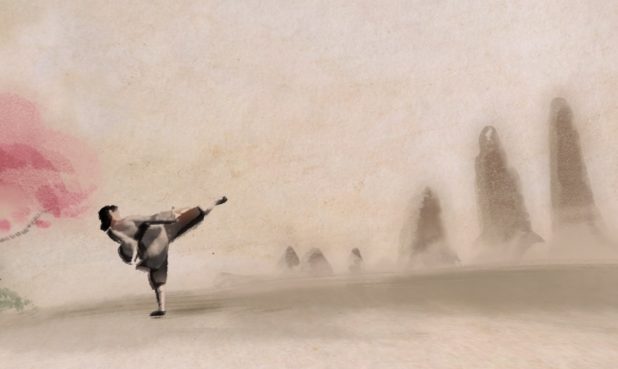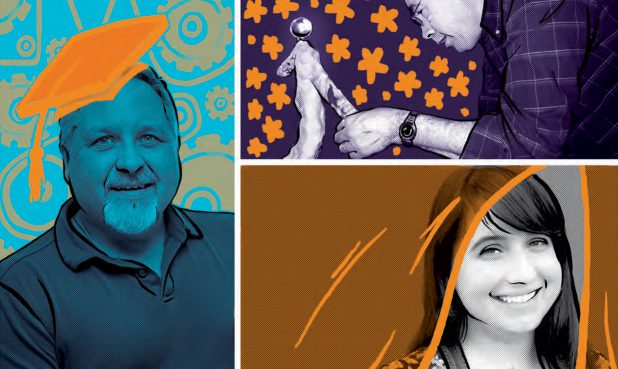We spoke to three members of the animation community who made the leap from being supporters of a cause, to taking on far more active roles in their desire to contribute. Be it raising awareness of gun violence, rescuing vulnerable animals, or fighting for the rights of undocumented immigrants, these artists explain what led them to take the first step on their journeys to make a difference.
Marlon West
Promoting a dialogue about gun violence
On January 1st, Marlon West set out to raise awareness about gun violence. His plan was to do one push-up for each person killed by guns in the United States during 2018. On days when no life was ended by a bullet, West thought he would hold plank position for thirty seconds. Now, 282 days into his year-long commitment, and the day when he just holds plank has yet to arrive. So far, the number has not even dropped into the single digits. The fewest number of push-ups he’s done was on Super Bowl Sunday, when the body count was 17.
Every day, before he gets out of bed, West checks the numbers on the Gun Violence Archive. He does a simple subtraction to figure out how many push-ups to do for that day. It’s a grim calculation and he admits that it weighs on him. He didn’t anticipate how much it would affect him, or the baseline of sadness that he carries with him since starting the project.
“When I compare it to people who have been shot or have lost a loved one…it’s a small weight to carry,” he says.
Somewhere between taking his daughter to school and going in to work at Walt Disney Animation Studios, he tries to find a quiet and compelling place to do the push-ups. He chooses parks or iconic landmarks around Los Angeles, to make it visually interesting for the videos he posts on Facebook, Instagram and Twitter. Often, he doesn’t have time to go anywhere, so he chooses locations at Disney where he works as Head of Effects Animation.
West has lost family members to gun violence, but he says that there wasn’t any watershed moment that prompted him to embark on this project, it was a culmination of things. He wanted to draw attention to every life lost to gun violence in the year and start a conversation about it. In each daily post he tries to include a particular story, so that people don’t just see a number. What became painfully obvious to him early on is the amount of gun deaths that are due to domestic violence, with many incidents that involved multiple gun deaths being murder-suicides. That was particularly shocking to discover.
He feels that the conversation around gun control needs to be reframed. “I think that people characterize each other as stridently for and stridently against—where the vast majority of people have a more reasonable position,” he explains. He believes a shift in approach could effect change that would have a meaningful impact on the body count that reaches tens of thousands a year. West points out that he’s not anti-gun, and says that people who are gun collectors, or hunters, or who live far from law enforcement and need to defend themselves, should be able to own guns. He does believe, however, that in America there are too many guns in the hands of people who shouldn’t have them. For example, simple changes—like waiting periods, universal background checks, storing guns with gun locks, an age limit of over 21 for gun owners—could save thousands of lives a year without taking guns away from people who are law-abiding citizens.
Reading his posts brings home the extent of the problem. On October 1st he wrote, “No mass shootings. Just a day when a lot of Americans killed each other.” That day the number of gun deaths was 72, the highest so far. West points out: “There was no newspaper article saying: Deadliest Day in America. No one’s tracking that—I only know it because I go onto the Gun Violence Archive every day and do the math.”
West’s journey can be followed online at @marlonw on twitter, @stlmarlonwest on Instagram and marlon.west1 on Facebook.

Eunsoo Jeong
Helping immigrants know their rights
If anyone understands what it’s like to face the daunting and complicated situation of being an undocumented immigrant, color designer Eunsoo Jeong has firsthand experience. Jeong came to the U.S. as an undocumented and unaccompanied minor at age 13 from Korea, sent by her single mother to live in San Francisco with her grandmother. Despite her challenging situation, she managed to get into San Jose State University’s animation program while working under the table for many years. “It was a difficult time,” Jeong says, as she explains how she felt lonely growing up and had no idea where to turn for help.
Her situation improved when, in 2013, she received DACA status and was hired as a production assistant on Nickelodeon’s Teenage Mutant Ninja Turtles. Now a permanent resident green-card holder through marriage, Jeong has not forgotten her own experiences and is committed to working with local immigration groups in helping undocumented immigrants.
Jeong explains that after graduating she was so focused on her career, she didn’t have time to process how much immigration and DACA had affected her. While she loved her work in animation and felt privileged to be a part of the industry, she realized she needed to do more. It was after attending an immigration conference in 2014 where she met young, undocumented immigrants who were fighting for their rights, that she realized she could be of help.
“I want people to know that they’re not alone…”
During a work hiatus she decided to use her down time to become more actively involved. She was able to get a fellowship with the UCLA Labor Center working with immigrants in Los Angeles, helping out with workshops aimed at informing immigrants of the options available to them and the kind of relief they could apply for. She assisted lawyers with translation into Korean and helped Korean American immigrants file their papers for citizenship. Jeong also made a short animation entitled “Know Your Rights” that was translated into several languages.
For her, it’s rewarding to put her talent to use for something beyond entertainment, and presenting information in a visual form is a helpful way to get the word out to people—explaining key and important material. At first, she didn’t realize the impact of her work, but soon people were reaching out to her, telling her the images were really powerful and that they had benefitted from them. Jeong continues to independently produce graphics and visuals that give people easy access to information. She also helps at a group called ICE out of L.A., providing help with flyers for immigration clinics and creating any artwork or visuals that may be needed. Most recently, Jeong designed artwork for “Artifax,” an online initiative that allows people to choose artworks designed around a particular cause, add a message, and then have it easily sent on to their representative in congress.
Jeong says that social activism makes her feel happy and healthy. She doesn’t want to forget her personal journey and the stories she hears from the immigrants keeps her grounded and inspires her to do more for the cause. “I want people to know that they’re not alone,” she says, adding how much it would have helped if she’d known she was not the only one in her situation when she was undocumented.
Jeong has worked as a color stylist on Shimmer and Shine and Pinky Malinky and as a background painter on Sanjay and Craig. She is currently working at DreamWorks TV as a freelance color designer.
Visit Artifax, Ice Out of LA, or UCLA Labor Union to learn more.

Caroline Foley
Addressing the needs of cats and the community
Caroline Foley has worked as a character designer/animator for Rick and Morty, a storyboard artist for BoJack Horseman and is co-creator/head story artist of Toasty Tales, amongst others. She has recently added another skill to her resume: cat rescuer. Foley has always been an animal lover and while she and her wife had already adopted a shelter cat, she always felt there was more that she could do. In June, when the entire department she worked in at Cartoon Network was dissolved, Foley suddenly found she no longer had the excuse that she didn’t have the time. “I could be part of the change or I could just sit at home and watch TV,” she says.
She immediately joined the volunteer foster program at the Burbank Animal Shelter. After going through the volunteer orientation and learning how to care for kittens and cats, Foley opted to foster two “bottle babies,” week-old kittens that needed round-the-clock help with care and feeding. Foley is now at the point where she’s helping to find permanent homes for them.
“It feels really good to know that I’ve been able to help because these kittens were just found in a box on a hillside somewhere in Burbank,” she says, adding it’s unlikely they would have survived on their own.
Foley explains that a perfect storm of events has led to an increased number of kittens and feral cats in Southern California. The warm weather enables cats to breed throughout the year, and as a result cats can become pregnant three or four times a year, with up to seven kittens in each litter. Kittens as young as four months can then become pregnant and so the problem escalates.
Another factor is that an injunction has put the Los Angeles city trap, neuter, return (TNR) program on hold. The program promotes the trapping of feral cats, which are neutered/spayed and then returned with the objective of preventing them from reproducing and reducing the overall number. There’s currently an injunction that prevents the City of Los Angeles from financially supporting the Trap, Neuter and Return program until the program has passed a CEQA (California Environmental Quality Act) review.
While the situation is being reviewed, cats that would have been fixed are now breeding all year long, leading to a huge feral cat population. For Foley, fostering was the quickest way to jump in and help, but she also wanted to address the larger issue. So on alternate Friday nights, she’s out in the Highland Park area with Luxe Paws, helping to catch feral cats as part of their privately funded TNR program. Special traps are used to catch cats, which are then taken to FixNation where they are spayed and neutered. The cats are then returned to their original locations.
Foley’s compassion for animals extends beyond cats. She’s currently working on an independent project using her artistic skills to create awareness of endangered plants and animals along the US/Mexico border. She’s compiling a book of illustrations of the endangered species and hopes to bring awareness to their plight and highlight how a border wall would negatively impact their survival.
Visit the Burbank Animal Shelter or Luxe Paws for more information.



